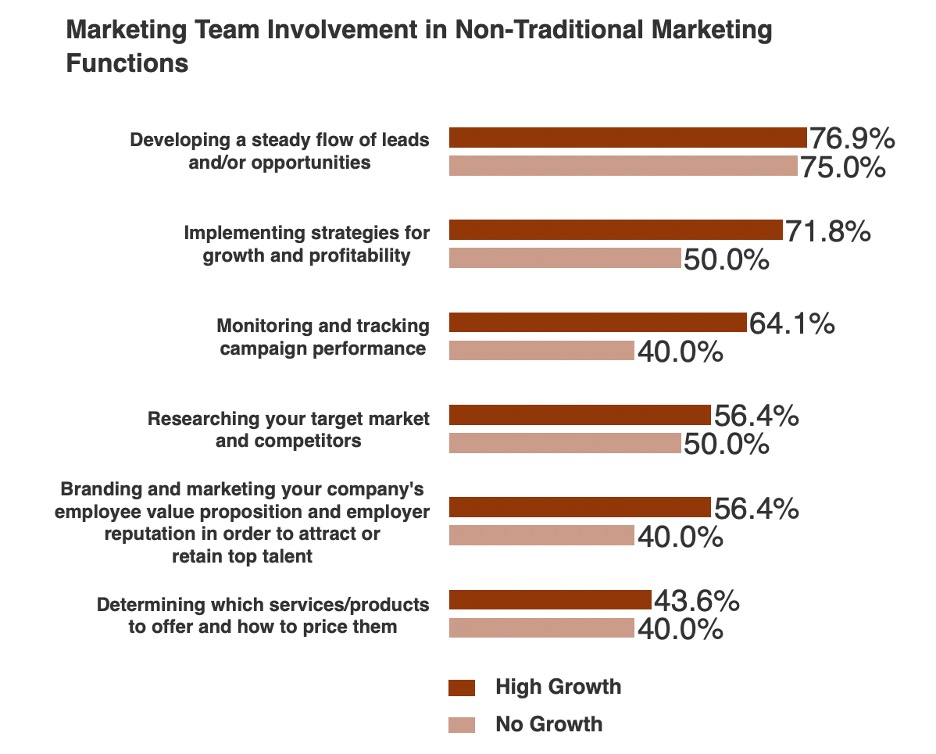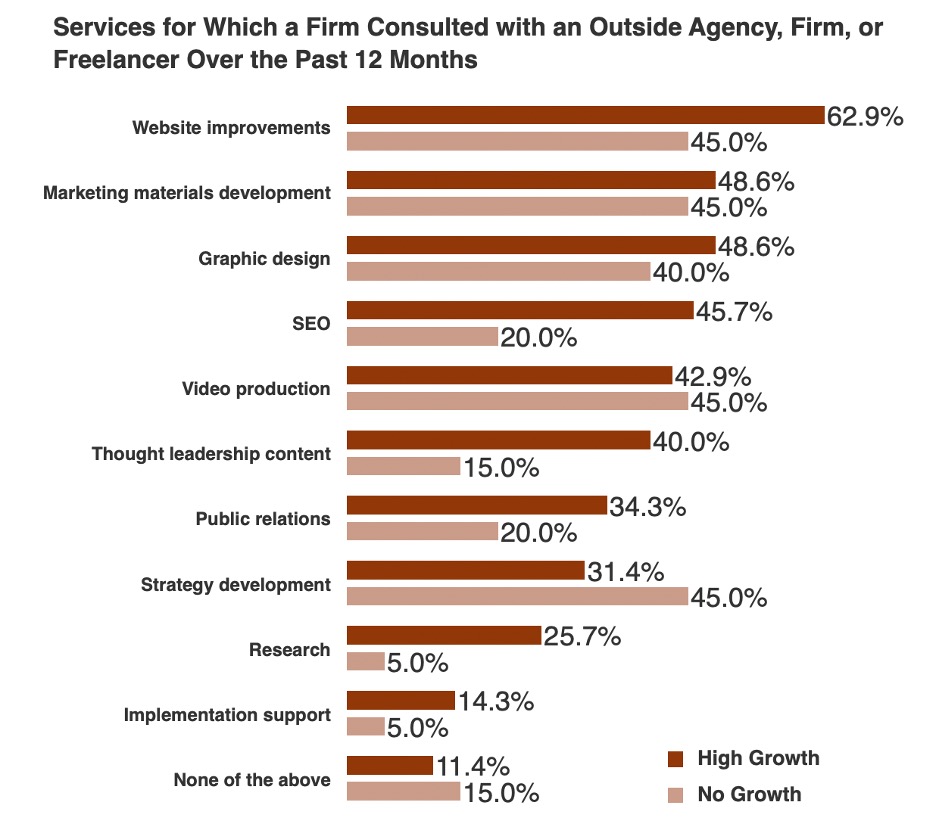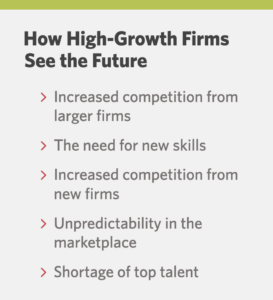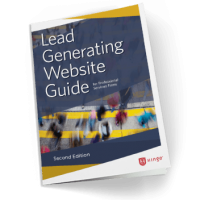For technology services and software firms, automation tools and the maturation of AI makes this a time of tremendous opportunity. As firms compete in a marketplace that is hypercompetitive, disrupted, and uncertain, having an effective IT marketing is more critical than ever.
But the marketing landscape is rife with a mind-boggling array of channels and techniques. In a previous article, I wrote that to achieve strong growth and profitability today’s IT marketing strategy can’t be built around just one or two high-performing techniques. Instead, you need a system of high-performing techniques. Our research shows that high-growth technology and software firms deliver this systemized approach to marketing at a higher and more mature level than their no-growth peers. They run their marketing like a well-oiled machine, built around a system of integrated parts that work in concert to generate robust growth and profitability in almost any environment.
In this article, I provide a detailed roadmap to build such a system.
IT Marketing Defined
The first step is to be clear about what we mean by “IT marketing.”
IT Marketing is the process of understanding your marketplace and competitors; defining your firm’s market positioning, pricing and services; promoting your firm to your target audience; and explaining how they might benefit by working with you. Put another way, marketing is about offering the right services with the right benefits to the right prospects.
At different firms, the role of marketing means different things — from a low-level support function charged with basic implementation responsibilities to a comprehensive team of specialists who deliver a full spectrum of strategic and operational skills.
Our research shows that high-growth technology services and software firms consider the marketing function to be more comprehensive compared to their no-growth peers. Notably, the marketing departments of high-growth technology and software firms are 44% more likely to be involved in implementing growth and profitability strategies and are 60% more likely to be tasked with staying on top of performance metrics and tying them to specific marketing campaigns.

High-growth firms also appreciate that marketing expertise does not necessarily need to reside in-house. In fact, they are more likely than their no-growth counterparts to consult with outside agencies or freelancers for several core marketing services, including website improvements, SEO, and thought leadership development.

High-Growth Marketing Strategies Assume a Highly Competitive Environment and An Ongoing Talent Shortage
Which challenges are most pressing for high-growth technology services and software firms? And which initiatives are they prioritizing to get ahead? Our annual High Growth Study tracks these trends — and identifies the evolving strategies and tactics favored by the high-growth firms compared to their slower-growing peers.
Consider, for example, the top five marketplace threats cited by technology services and software firms.
 When compared to results from across other professional services industries, increased competition from both existing players and newcomers is a shared perceived threat. This challenge is likely to grow as more and more competitors enter the technology marketplace and vie for a limited number of buyers.
When compared to results from across other professional services industries, increased competition from both existing players and newcomers is a shared perceived threat. This challenge is likely to grow as more and more competitors enter the technology marketplace and vie for a limited number of buyers.
There’s a major difference between technology services and other industries, however: the two-sided impact that automation and AI brings to the fore. On the one hand, these innovations help firms bring new and better offerings to market that can be delivered faster/better/cheaper than ever before. On the other, the very innovations that propel established firms forward also make it easier for newcomers to enter the market with cutting-edge tools. The result is downward pressure on price and the commoditization of some services.
6 Essential IT Marketing Strategies
How do technology services and software firms address these threats and build competitive advantage? Our research revealed six key strategies that can help firms win:
1. Work on Your Digital Maturity
High-growth firms use technology at a higher, more sophisticated level than their no-growth peers. In fact high-growth technology services and software firms are more than twice as likely to have undergone a digital transformation, as show in the chart below:
 We also measured five levels of digital maturity, ranging from the earliest stages where nearly all processes remain manual and use of spreadsheets is prevalent, to a highly mature stage where data is complete and consistent, processes are fully aligned with business needs, and the company has the ability to include other people, such as customers, into the process. Our findings showed that over half (55%) of no-growth firms are in one of the two lowest stages of maturity, while one in five high-growth technology and software firms has reached the highest stage of digital maturity.
We also measured five levels of digital maturity, ranging from the earliest stages where nearly all processes remain manual and use of spreadsheets is prevalent, to a highly mature stage where data is complete and consistent, processes are fully aligned with business needs, and the company has the ability to include other people, such as customers, into the process. Our findings showed that over half (55%) of no-growth firms are in one of the two lowest stages of maturity, while one in five high-growth technology and software firms has reached the highest stage of digital maturity.
2. Use Content Marketing to Educate Your Audienc
At Hinge, we are big proponents of putting educational content at the heart of your marketing strategy. In fact, the “content funnel” should be the key for your IT services marketing—where it can reach new interested audiences and move them over time toward a close.
Content marketing encompasses many types of content types distributed across a variety of channels, including your website, blog, and social media platforms. Through media, professional partners, content syndication, and guest blogging, you can spread your expertise to a range of new audiences.
This is the core goal of content marketing: By educating your audiences and addressing their challenges through expert content, you will build visibility, credibility and loyalty that will ultimately lead to new business and growth.
3. Turn Your Brochure Website into a High Performing Workhorse
In the past, many tech firms grew primarily by word of mouth and trade media coverage. Innovative technology almost sold itself, so these firms didn’t have to market much—which is why even today many tech firms have poor websites. Websites are sometimes treated as an online brochure—a place to describe products and services—with few ways to engage visitors or interact with the firm and its experts.
Today, particularly in the technology services industry, websites must be built to engage and convert. This type of website is designed to reach new audiences every day and build a loyal following. For prospective clients, a high-performance website is a direct indicator of a firm’s credibility. Our research on referral marketing shows that an unimpressive website—one that has undifferentiated messaging, generic imagery, and a low wow factor, is among the top reasons that buyers rule out referrals.
But a website isn’t just a tool to help firms avoid getting ruled out during the buyer’s evaluation process. It should be an active persuader. It should be the hub of a firm’s marketing program—supplying free expert content, differentiated messaging, benefit-oriented service pages, conversion mechanisms, and more. According to our research, 80% of buyers use your website to check you out—so you can’t afford not to make a powerful impression.
Remember, too, that websites have to perform seamlessly wherever they are displayed, whether on a phone, tablet or desktop computer. Mobile browsing has become so important that Google has made a site’s mobile experience an important factor in search rankings. To this end, your site should be built with fast-loading responsive design principles, optimizing your pages on the fly to any screen size.
4. Publish Original Research
Many high-growth IT services firms separate their content strategies from those of their no-growth firms by publishing original research. Earlier, I noted that high-growth firms deliver more marketing muscle by building an interconnected system of marketing techniques. Publishing original research can take this approach to the next level. Research not only helps marketing, business development, and senior management teams see the marketplace more clearly, it can often be repurposed as premium content to generate more visibility, trust, engagement, and leads. Research can be used in its entirety (a published study) or in pieces (charts, findings, insights, quotes) throughout your sales & marketing funnel. Whatever it’s format, research can be a deep well of interesting content for social media, events, videos, articles/blogs, speaking engagements, webinars, guides, demos, and consultations.

5. Build a Differentiated Brand
Our research has shown that high-growth firms are almost three times more likely to have a strong differentiator. There is good reason that high-growth technology services and software firms prioritize differentiation as a top strategy: in addition to setting firms apart from their competition, a robust brand differentiation strategy allows firms to be more targeted in their marketing, speaking directly to the most relevant audiences. Worse, if you don’t have a strong differentiator, the only option left is to compete on price—and that’s almost always a dispiriting race to the bottom. Put simply, your brand’s differentiators are among your most important assets. They facilitate your relationship with buyers and influencers and they ultimately drive your reputation and pace of growth.
6. Embrace Search Engine Optimization (SEO)
Like the technology services and software marketplace as a whole, SEO is constantly evolving—and it’s crucial to keep up. Google’s algorithm receives multiple updates each year, some with major consequences. But in a hypercompetitive environment where visibility is critical, SEO is mandatory.
What do firms need to know about SEO? Here’s a very high-level summary: On-site SEO uses targeted keyword phrases associated with your services and expertise to attract qualified readers who use search to answer their questions. Some of these readers will eventually buy your services. There are also technical considerations, such as the authority of your site, page load speed, and mobile device optimization, that can affect your potential rankings.
Off-site SEO increases your site’s perceived authority through links to your pages, especially your content. Common channels are social media, brand mentions, and external thought leadership pieces like guest articles. For a more detailed plan of action, we’ve developed an SEO strategy for B2B firms.
Conclusion
There is a lesson to be learned from firms that are thriving in this still uncertain environment—organizations that are not only growing at a rapid clip, but are highly profitable, too. That lesson? Think of your IT marketing and business development strategies—and the people, processes, and programs that support them—as a system of interconnected parts. A system that runs like a well-oiled machine, using data and analysis to eliminate guesswork, automation to create efficiencies, and sophisticated content marketing tools and techniques to build visibility and deliver a steady stream of high-quality leads.
That’s how the best performing firms outperform the rest of the industry year after year. And it’s how you can, too.
How Hinge Can Help
Hinge has developed a comprehensive plan, the Visible Firm® to address these issues and more. It is the leading marketing program for delivering greater visibility, growth, and profits. This customized program will identify the most practical offline and online marketing tools your firm will need to gain new clients and reach new heights.
Additional Resources
- Our Lead Generating Website Guide details how your firm can generate qualified leads with its website.
- Ensure that your website and content gets found online with Hinge’s SEO Guide for Professional Services.
- Explore how successful technology firms are using online marketing to grow faster and be more profitable, download the Online Marketing for Professional Services


